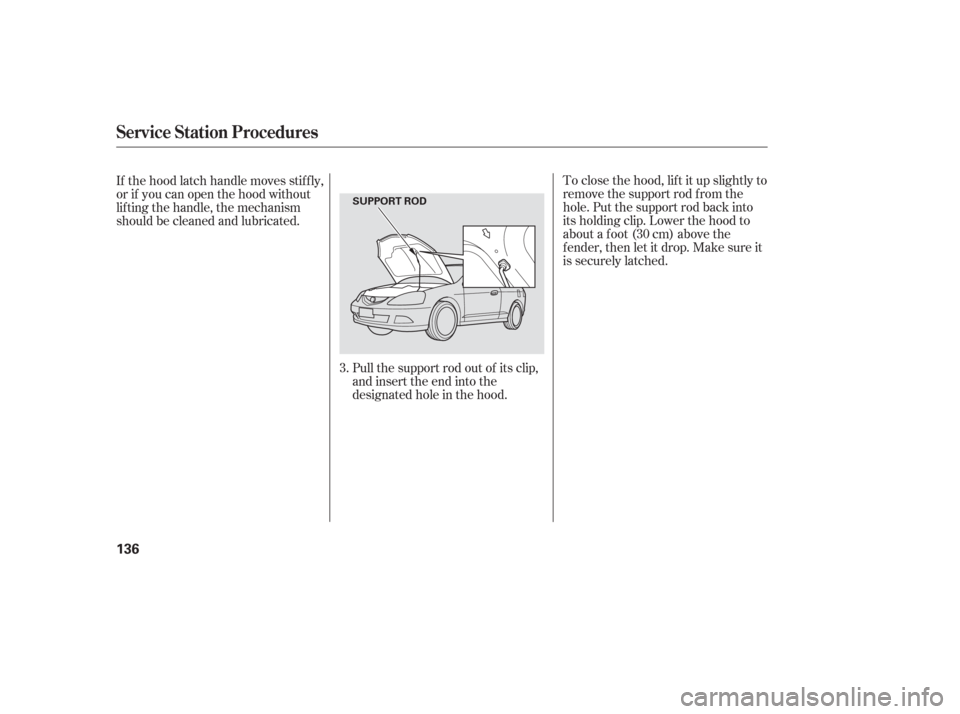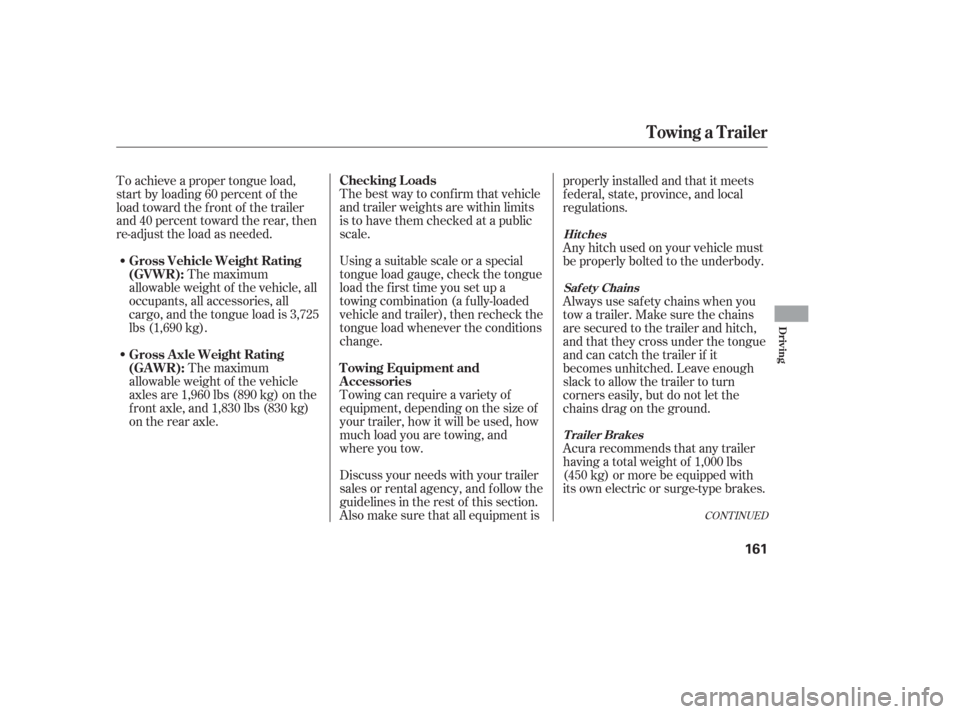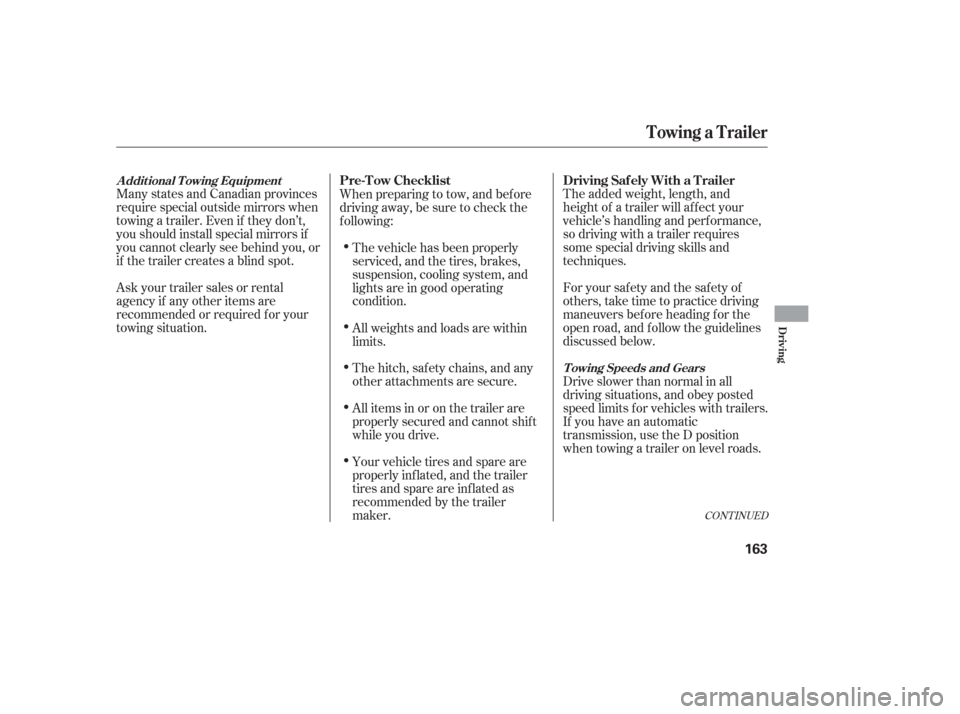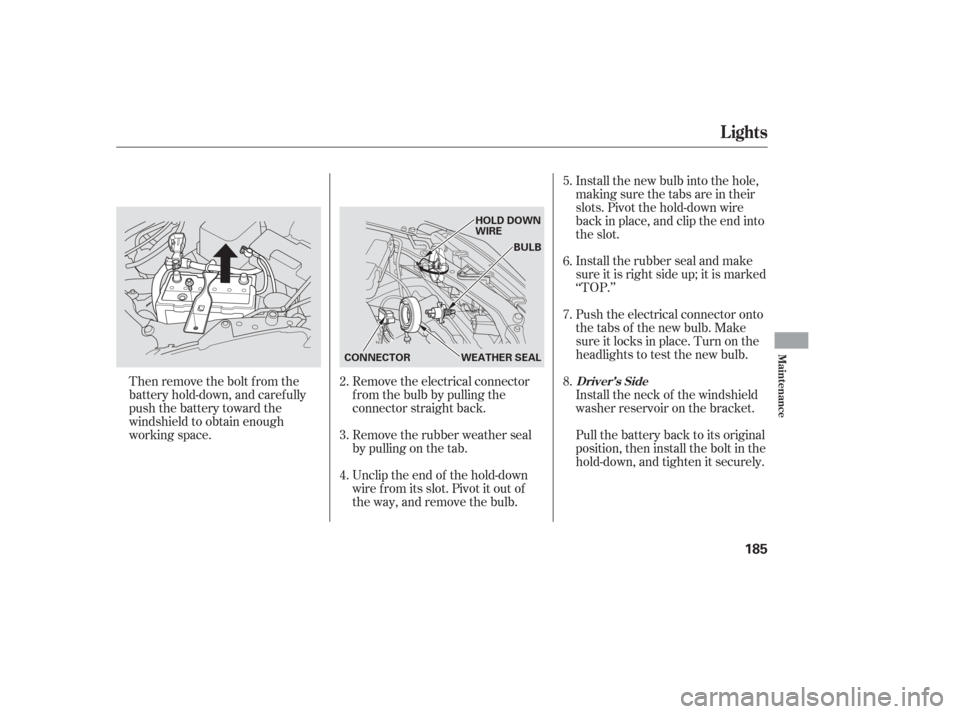ECU Acura RSX 2006 Owner's Guide
[x] Cancel search | Manufacturer: ACURA, Model Year: 2006, Model line: RSX, Model: Acura RSX 2006Pages: 255, PDF Size: 3.41 MB
Page 137 of 255

Pull the support rod out of its clip,
and insert the end into the
designated hole in the hood.To close the hood, lif t it up slightly to
remove the support rod f rom the
hole. Put the support rod back into
its holding clip. Lower the hood to
about a f oot (30 cm) above the
f ender, then let it drop. Make sure it
is securely latched.
If the hood latch handle moves stif f ly,
or if you can open the hood without
lif ting the handle, the mechanism
should be cleaned and lubricated.
3.
Service Station Procedures
136
SUPPORT ROD
Page 144 of 255

Store or secure all items that could
be thrown around and hurt
someone during a crash.If you carry large items that
prevent you f rom closing the
hatch, exhaust gas can enter the
passenger area. To avoid the
possibility of
, f ollow the instructions
on page .
Distribute cargo evenly on the
f loor of the cargo area, placing the
heaviest items on the bottom and
as far forward as possible.
If youfolddownthebackseat,tie
down items that could be thrown
about the vehicle during a crash or
sudden stop.
Do not place items on the cargo
area cover, or stack objects higher
than the top of the back seat. They
could block your view and be
thrown about the vehicle during a
crash or sudden stop.
Be sure items placed on the f loor
behind the f ront seats cannot roll
under the seats and interf ere with
the driver’s ability to operate the
pedals or the proper operation of
the seats.
Keep the glove box closed while
driving. If it is open, a passenger
could injure their knees during a
crash or sudden stop.
45
Carrying Items in the Passenger
Compartment
carbon monoxide
poisoning
Carrying Cargo in the Cargo A rea
Carrying Cargo
Bef ore Driving
143
Page 147 of 255

Youshoulddothefollowingchecks
and adjustments every day bef ore
you drive your vehicle.Make sure all windows, mirrors,
and outside lights are clean and
unobstructed. Remove f rost, snow,
or ice. Check the seat adjustment (see
page ).
Check the adjustment of the
inside and outside mirrors (see
page ).
Check the steering wheel
adjustment (see page ).
Make sure the doors and the
hatch are securely closed and
locked.When you start the engine, check
the gauges and indicators in the
instrument panel (see page ).
Check that the hood is f ully closed. Fasten your seat belt. Check that
your passengers have f astened
their seat belts (see page ).
Check that the hatch is f ully
closed.
Check that any items you may be
carrying are stored properly or
f astened down securely. Visually check the tires. If a tire
looks low, use a gauge to check its
pressure.
1.
2.
3.
9. 8. 7. 6.
5. 4. 10. 11.
71
79 63
15 51
Preparing to Drive
146
Page 158 of 255

Always use the parking brake when
you park your vehicle. Make sure
the parking brake is set f irmly or
your vehicle may roll if it is parked
on an incline.
If your vehicle has an automatic
transmission, set the parking brake
bef ore you put the transmission in
Park. This keeps the vehicle f rom
moving and putting pressure on the
parking mechanism in the
transmission.If the vehicle is f acing uphill, turn
the front wheels away from the
curb. If you have a manual
transmission, put it in f irst gear.
If the vehicle is f acing downhill,
turn the front wheels toward the
curb. If you have a manual
transmission, put it in reverse gear.
Make sure the parking brake is
f ully released bef ore driving away.
Driving with the parking brake
partially set can overheat or
damage the rear brakes.
Make sure the moonroof (if
equipped) and the windows are
closed.
Never park over dry leaves, tall
grass, or other f lammable
materials. The hot three way
catalytic converter could cause
these materials to catch on fire. Lock the doors. Place any packages, valuables, etc.
in the cargo area or take them
with you. Turn of f the lights.
Check the indicator on the driver’s
door to verify that the security
system is set.
On vehicles with security system
Parking T ips
Parking
Driving
157
Page 162 of 255

CONT INUED
The best way to conf irm that vehicle
and trailer weights are within limits
is to have them checked at a public
scale.
Using a suitable scale or a special
tongue load gauge, check the tongue
load the f irst time you set up a
towing combination (a f ully-loaded
vehicle and trailer), then recheck the
tongue load whenever the conditions
change.
To achieve a proper tongue load,
start by loading 60 percent of the
load toward the front of the trailer
and 40 percent toward the rear, then
re-adjust the load as needed.
Towing can require a variety of
equipment, depending on the size of
your trailer, how it will be used, how
much load you are towing, and
where you tow.
The maximum
allowable weight of the vehicle, all
occupants, all accessories, all
cargo, and the tongue load is 3,725
lbs (1,690 kg).
The maximum
allowable weight of the vehicle
axles are 1,960 lbs (890 kg) on the
f ront axle, and 1,830 lbs (830 kg)
on the rear axle.
Discuss your needs with your trailer
sales or rental agency, and f ollow the
guidelines in the rest of this section.
Also make sure that all equipment is properly installed and that it meets
f ederal, state, province, and local
regulations.
Any hitch used on your vehicle must
be properly bolted to the underbody.
Acura recommends that any trailer
having a total weight of 1,000 lbs
(450 kg) or more be equipped with
its own electric or surge-type brakes. Always use saf ety chains when you
tow a trailer. Make sure the chains
are secured to the trailer and hitch,
and that they cross under the tongue
and can catch the trailer if it
becomes unhitched. Leave enough
slack to allow the trailer to turn
corners easily, but do not let the
chains drag on the ground.
Towing a Trailer
Checking L oads
T owing Equipment and
A ccessories
Gross Vehicle Weight Rating
(GVWR):
Gross Axle Weight Rating
(GA WR):
Hitches
Saf et y Chains
Trailer Brakes
Driving
161
Page 164 of 255

Many states and Canadian provinces
require special outside mirrors when
towing a trailer. Even if they don’t,
you should install special mirrors if
you cannot clearly see behind you, or
if the trailer creates a blind spot.
Askyourtrailersalesorrental
agency if any other items are
recommended or required f or your
towing situation.The added weight, length, and
height of a trailer will af f ect your
vehicle’s handling and perf ormance,
so driving with a trailer requires
some special driving skills and
techniques.
Foryoursafetyandthesafetyof
others,taketimetopracticedriving
maneuvers bef ore heading f or the
open road, and f ollow the guidelines
discussed below.
When preparing to tow, and bef ore
driving away, be sure to check the
f ollowing:
The vehicle has been properly
serviced, and the tires, brakes,
suspension, cooling system, and
lights are in good operating
condition.
All items in or on the trailer are
properly secured and cannot shif t
while you drive.
Your vehicle tires and spare are
properly inf lated, and the trailer
tires and spare are inflated as
recommended by the trailer
maker. Thehitch,safetychains,andany
other attachments are secure. All weights and loads are within
limits.
Drive slower than normal in all
driving situations, and obey posted
speed limits f or vehicles with trailers.
If you have an automatic
transmission, use the D position
when towing a trailer on level roads.
CONT INUED
Towing a Trailer
A ddit ional T owing Equipment
T owing Speeds and GearsDriving Saf ely With a T railer
Pre-T ow Checklist
Driving
163
Page 175 of 255

Make sure the API Certif ication Seal
says ‘‘For Gasoline Engines.’’
The oil’s viscosity or weight is
provided on the container’s label.
5W-20 oil is f ormulated f or year-
round protection of your vehicle, to
improve cold weather starting and
f uel economy.
Unscrew and remove the engine oil
fill cap on the valve cover. Pour in
the oil slowly and caref ully so you do
not spill any. Clean up any spills
immediately. Spilled oil could
damage components in the engine
compartment.
Reinstall the engine oil f ill cap, and
tighten it securely. Wait a f ew
minutes, and recheck the oil level on
the engine oil dipstick. Do not f ill
above the upper mark; you could
damage the engine. Oil is major contributor to your
engine’s perf ormance and longevity.
Always use a premium-grade
detergent oil displaying the API
Certif ication Seal. This seal indicates
the oil is energy conserving, and that
it meets the American Petroleum
Institute’s latest requirements. It is
highly recommended that you use
Acura Precision Craf ted motor oil in
your vehicle.
RSX and Premium models
A dding Engine Oil
Recommended Oil
174
ENGINE OIL FILL CAP
API CERTIFICATION SEAL Ambient Temperature
Page 181 of 255

Insert the dipstick all the way back
into the transmission securely as
shown in the illustration.
The transmission should be drained
and ref illed with new f luid according
to the time and distance recommen-
dations in the maintenance schedule.
If you are not sure how to add f luid,
contact your dealer.
If the level is below the lower
mark, remove the f ill plug and add
f luid to bring it to the upper mark.
Pour the f luid slowly and caref ully
so you do not spill any. Clean up
any spill immediately; it could
damage components in the engine
compartment.
Insert the dipstick all the way into
the transmission securely.
Remove the dipstick, and check
the f luid level. It should be
between the upper and lower
marks. Always use Acura Precision Craf ted
ATF-Z1 (automatic transmission
f luid). If it’s not available, you may
use a DEXRON
III automatic
transmission f luid as a temporary
replacement. However, continued
use can affect the shift quality. Have
the transmission f lushed and ref illed
with Acura ATF-Z1 as soon as it is
convenient. To thoroughly f lush the transmission,
the technician should drain and ref ill
it with Acura ATF-Z1, then drive the
vehicle f or a short distance. Do this
three times. Then drain and ref ill the
transmission a final time.
6.
5.
3.
4.
Automatic Transmission Fluid
180
UPPER
MARK
LOWER
MARK
Page 182 of 255

Check the f luid level in the
reservoirs monthly.
Replace the brake f luid according to
the time recommendation in the
maintenance schedule.
Always use Acura Precision Craf ted
Heavy Duty Brake Fluid DOT 3. If it
is not available, you should use only
DOT 3 or DOT 4 f luid, f rom a sealed
container, as a temporary
replacement.
Using any non-Acura brake f luid can
cause corrosion and decrease the lif e
of the system. Have the brake
system f lushed and ref illed with
Acura Heavy Duty Brake Fluid
DOT 3 as soon as possible.
Brake f luid marked DOT 5 is not
compatible with your vehicle’s
braking system and can cause
extensive damage.
Check the f luid level with the
transmission at normal operating
temperature and the vehicle sitting
on level ground. Remove the
transmission f iller bolt and caref ully
f eel inside the bolt hole with your
f inger. The f luid level should be up
to the edge of the bolt hole. If it is
not, add Acura Precision Craf ted
Manual Transmission Fluid (MTF) until it starts to run out of the hole.
Reinstall the f iller bolt tighten it
securely.
If Acura MTF is not available, you
may use an SAE 10W-30 or 10W-40
viscosity motor oil with the API
Certif ication seal that says ‘‘FOR
GASOLINE ENGINES’’ as a
temporary replacement. However,
motor oil does not contain the proper
additives, and continued use can
cause stiffer shifting. Replace as
soon as it is convenient.
The transmission should be drained
and ref illed with new f luid according
to the time and distance recommen-
dations in the maintenance schedule.
On vehicles with 5-speed/6-speed
manual transmission
Brake FluidManual T ransmission Fluid
Manual Transmission Fluid and Brake Fluid
Maint enance
181
Correct level
FILLER BOLT
Page 186 of 255

Install the rubber seal and make
sure it is right side up; it is marked
‘‘TOP.’’
Pull the battery back to its original
position, then install the bolt in the
hold-down, and tighten it securely. Push the electrical connector onto
the tabs of the new bulb. Make
sure it locks in place. Turn on the
headlights to test the new bulb.
Install the neck of the windshield
washer reservoir on the bracket.
Then remove the bolt f rom the
battery hold-down, and caref ully
push the battery toward the
windshield to obtain enough
working space.
Unclip the end of the hold-down
wire f rom its slot. Pivot it out of
the way, and remove the bulb. Remove the rubber weather seal
by pulling on the tab. Remove the electrical connector
f rom the bulb by pulling the
connector straight back.Install the new bulb into the hole,
making sure the tabs are in their
slots. Pivot the hold-down wire
back in place, and clip the end into
the slot.
3.
4. 5.
6.
7.
8.
2.
Lights
Driver’s Side
Maint enance
185
HOLD DOWN
WIRE
BULB
WEATHER SEAL
CONNECTOR